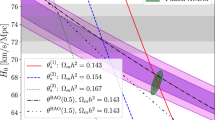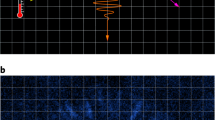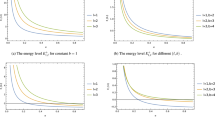Abstract
THE observed isotropy of the microwave background and its primordial interpretation has led many to investigate the nature of particle horizons in cosmological models near the initial singularity. The standard Friedmann radiation universe  has a particle horizon at
has a particle horizon at  at epoch t. Thus near the singularity t = 0, very limited causal communication is possible between different parts of the universe. The observed isotropy of the microwave background cannot be understood in such a model except as arising from artificially imposed initial conditions, Misner1 has sought to remedy the situation by looking for solutions of the classical Einstein equations very different from the Robertson-Walker form (to which that given by equation 1 above belongs). These solutions permit unlimited communication near t = 0.
at epoch t. Thus near the singularity t = 0, very limited causal communication is possible between different parts of the universe. The observed isotropy of the microwave background cannot be understood in such a model except as arising from artificially imposed initial conditions, Misner1 has sought to remedy the situation by looking for solutions of the classical Einstein equations very different from the Robertson-Walker form (to which that given by equation 1 above belongs). These solutions permit unlimited communication near t = 0.
This is a preview of subscription content, access via your institution
Access options
Subscribe to this journal
Receive 51 print issues and online access
$199.00 per year
only $3.90 per issue
Buy this article
- Purchase on Springer Link
- Instant access to full article PDF
Prices may be subject to local taxes which are calculated during checkout
Similar content being viewed by others
References
Misner, C. W., Phys. Rev. Lett., 22, 1071 (1969).
Feynman, R. P., Rev. Mod. Phys., 20, 367 (1948).
Wheeler, J. A., Relativity Groups and Topology (1963 Les Houches Lectures), (Gordon and Breach, New York, 1964).
Author information
Authors and Affiliations
Rights and permissions
About this article
Cite this article
HOYLE, F., NARLIKAR, J. Effect of Quantum Conditions in a Friedmann Cosmology. Nature 228, 544–545 (1970). https://doi.org/10.1038/228544c0
Received:
Issue Date:
DOI: https://doi.org/10.1038/228544c0
This article is cited by
-
Quantum fluctuations near the classical space-time singularity
General Relativity and Gravitation (1979)
-
Quantum uncertainty in the final state of gravitational collapse
Nature (1977)
-
Wheeler–Feynman Quantum Theory
Nature Physical Science (1971)
-
Mixmaster Universe Problem
Nature Physical Science (1971)
Comments
By submitting a comment you agree to abide by our Terms and Community Guidelines. If you find something abusive or that does not comply with our terms or guidelines please flag it as inappropriate.



